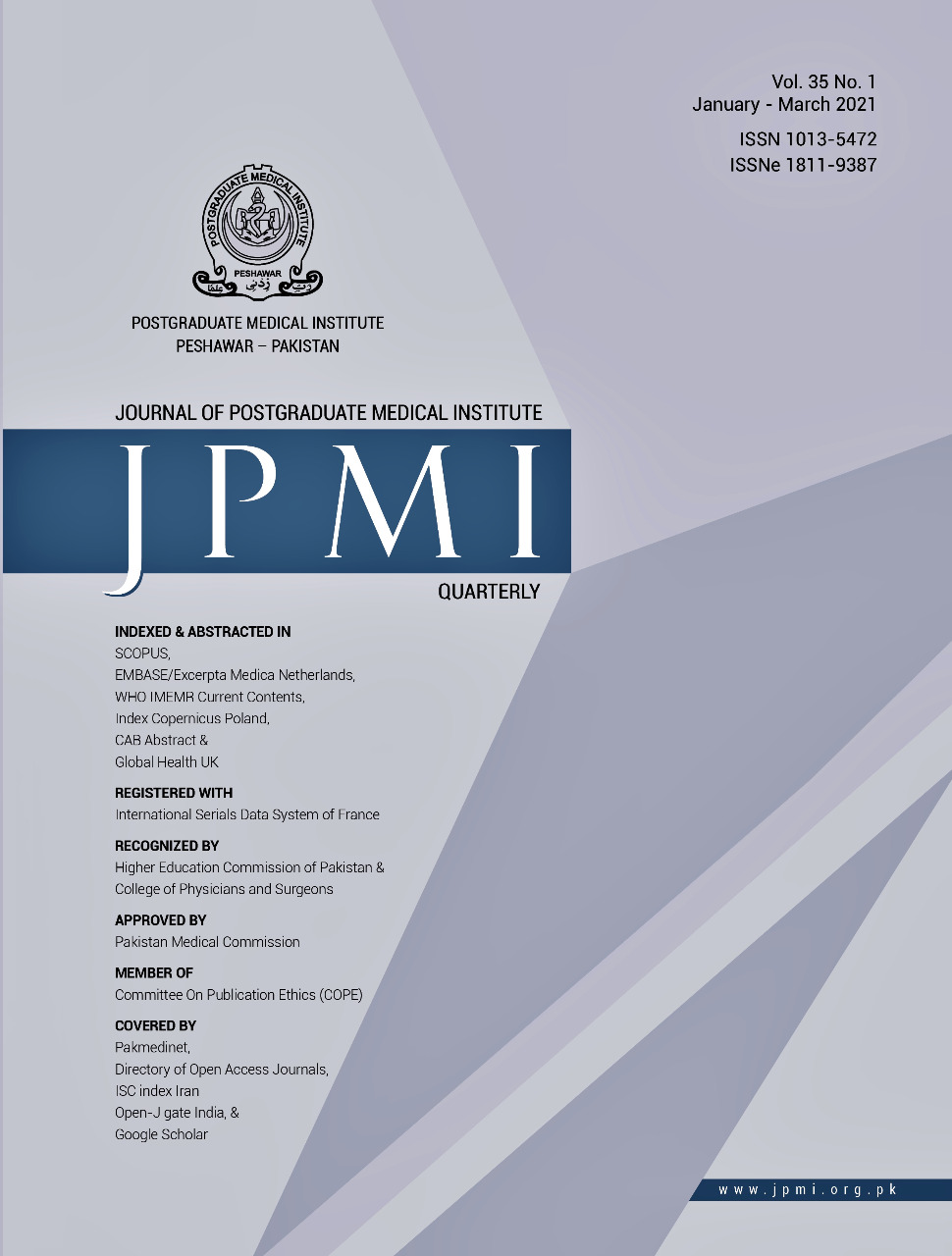TUBAL ECTOPIC PREGNANCY AND THE DETERMINANTS OF ITS DIFFERENT TREATMENT OPTIONS
Main Article Content
Abstract
Objective: To find out the determinants affecting the different management options of tubal ectopic pregnancy.
Methodology: This cross sectional study was carried out in the Unit A of the department of obstetrics and gynecology, Hayatabad Medical Complex, Peshawar from December 2014 to March 2018. All the patients admitted with clinical/ultrasound diagnosis of tubal ectopic pregnancy were included in the study through convenient sampling technique after informed consent. Patients having other early pregnancy problems which would mimic tubal ectopic pregnancy and those having any medical contraindications to Methotrexate were excluded. A pre-designed performa was used to collect the data, which was analyzed using SPSS v.22.0.
Results: The mean age of the sample (n=78) was 27.0±7.8 years. Maximum patients were multigravida (n=41, 52.6%), followed by primigravida (n=25, 32.0%). In treatment modalities, maximum of the cases (n=43, 55.1%) were managed medically via methotrexate with success rate of 93.0%, while 18 (23.1%) cases were managed conservatively with success rate of 83.3%, and 17 (21.8%) of the cases were managed surgically with 100% success rate. The maximum size of adnexal mass was found to be as 8.6×7, 10×7, and 8×6 in three management options, i.e., conservative, medical and surgical respectively, while in the same categories, maximum Beta-Human Chorionic Gonadotropin (B-hCG) level was found to be as 978, 43220, and 29844 mIU/ml respectively.
Conclusion: Hemodynamic instability and rising B-hCG were the core determinants in the management of tubal ectopic pregnancy. The size of the adnexal mass and the initial B-hCG did not affect the management.
Article Details
Work published in JPMI is licensed under a
Creative Commons Attribution-NonCommercial 2.0 Generic License.
Authors are permitted and encouraged to post their work online (e.g., in institutional repositories or on their website) prior to and during the submission process, as it can lead to productive exchanges, as well as earlier and greater citation of published work.
References
Marion LL, Meeks GR. Ectopic preg¬nancy: History, incidence, epidemiolo¬gy, and risk factors. Clin Obstet Gyne¬col. 2012;55(2):376-86. https://doi. org/10.1097/GRF.0b013e3182516d7b.
Creanga AA, Shapiro-Mendoza CK, Bish CL, Zane S, Berg CJ, Callaghan WM. Trends in ectopic pregnancy mortality in the United States: 1980–2007. Obstet Gynecol. 2011;117:837-43. https://doi. org/10.1097/AOG.0b013e3182113c10.
Bottomley C, Bourne T. Diagnosing ec¬topic pregnancy and current concepts in the management of pregnancy of unknown location. Hum Reprod Up¬date. 2014;20:250-61. https://doi. org/10.1093/humupd/dmt047.
D’Hooghe T, Tomassetti C. Surgery for ec¬topic pregnancy: making the right choice. Lancet. 2014;383:1444-5. https://doi. org/10.1016/S0140-6736(14)60129-X.
Seeber BE, Sammel MD, Guo W, Zhou L, Hummel A, Barnhart KT. Application of redefined human chorionic gonado¬tropin curves for the diagnosis of wom¬en at risk for ectopic pregnancy. Fer¬til Steril. 2006;86:454-9. https://doi. org/10.1016/j.fertnstert.2005.12.056.
Condous G. Kirk E, Van Calster B, van Huffel S, Timmerman D, Bourne T. Failing pregnancies of unknown location: a pro¬spective evaluation of the human chorionic gnadotrophin ratio. BJOG. 2006;113:521- 7. https://doi.org/10.1111/j.1471- 0528.2006.00924.x.
Panelli DM, Phillip CH, Brady PC. Inci¬dence, diagnosis and management of tubal and nontubal ectopic pregnancies: a review. Fertil Res Pract. 2015;1:15-34. https://doi.org/ 10.1186/s40738-015- 0008-z.
Ali R, Afzal U. Ectopic pregnancy; medi¬cal management. Professional Med J. 2012;19(2):242-5.
Inal ZO, Inal HA. Comparison of four methods of treating ectopic pregnancy. A retrospective cohort study. Geburtsh Frauenheilk. 2018;78:70-7. https://doi. org/10.1055/s-0043-122151.
Elson J, Tailor A, Banerjee S, Salim R, Hillaby K, Jurkovic D. Expectant man¬agement of tubal ectopic pregnancy: prediction of successful outcome using decision tree analysis. Ultrasound Obstet Gynecol. 2004;23:552-6. https://doi. org/10.1002/uog.1061.
Korhonen J, Stenman UH, Ylostalo P. Serum human chorionic gonadotrophin dynamics during spontaneous resolu-tion of ectopic pregnancy. Fertil Steril. 1994;61:632-6. https://doi.org/10.1016/ s0015-0282(16)56638-2.
Natale A, Busacca M, Candiani M, Gruft L, Izzo S, Felicetta I, et al. Human cho¬rionic gonadotropin patterns after a single dose of methotrexate for ectopic pregnancy. Eur J Obstet Gynecol Reprod Biol. 2002;100:227-30. https://doi. org/10.1016/s0301-2115(01)00480-8.
Kirk E, Condous G, van Calster B, van Huffle S, Timmerman D, Bourne T. Rationalizing the follow up of pregnancies of unknown location. Hum Reprod. 2007;22:1744- 50. https://doi.org/10.1093/humrep/ dem073.
Shaikh NB, Shaikh S, Shaikh F. A clinical study of ectopic pregnancy. J Ayub Med Coll Abbottabad. 2014;26(2):178-81.
Barnart KT, Gsman G, Ashby R, Sammel M. The medical management of ectopic preg¬nancy: a meta-analysis comparing ‘single dose’ and ‘multidose’ regimens. Obstet Gynecol. 2003;101:778-84. https://doi. org/10.1016/s0029-7844(02)03158-7.
Jurkovic D, Memtsa M, Sawyer E, Don¬aldson ANA, Jamila A, Schramm K, et al. Single-dose systemic methotrexate vs expectant management for treatment of tubal ectopic pregnancy: a placebo-con¬trolled randomized trial. Ultrasound Ob¬stet Gynecol. 2017;49:171-6. https://doi. org/10.1002/uog.17329.
Practice Committee of the American So¬ciety for Reproductive Medicine. Medical treatment of ectopic pregnancy a commit¬tee opinion. Fertil Steril. 2013;100:638- 64. https://doi.org/10.1016/j.fertnstert.2013.06.013.
Jaspan D, Giraldo-Isaza M, Dandolu V, Cohen AW. Compliance with methotrex¬ate therapy for presumed ectopic preg¬nancy in an inner-city population. Fertil Steril. 2010;94:1122-4. https://doi. org/10.1016/j.fertnstert.2009.10.032.


